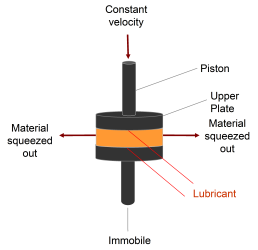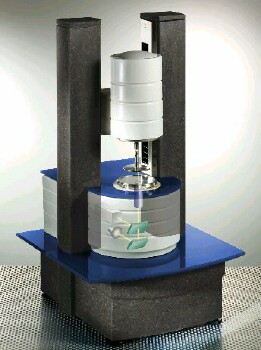Rheometers
A Rheometer is a laboratory device used to measure the way in which a liquid, suspension or slurry flows in response to applied forces. It is used for those fluids which cannot be defined by a single value of viscosity and therefore require more parameters to be set and measured than is the case for Viscometers. It measures the rheology of the fluid.There are two distinctively different types of rheometers. Rheometers that control the applied shear stress or shear strain are called rotational or shear rheometers, whereas rheometers that apply extensional stress or extensional strain are extensional rheometers. Rotational or shear type rheometers are usually designed as either a native strain-controlled instrument or a native stress-controlled instrument .
The word rheometer comes from the Greek, and means a device for measuring flow. In the 19th century it was commonly used for devices to measure electric current, until the word was supplanted by galvanometers and Ammeters. It was also used for the measurement of flow of liquids, in medical practice and in civil engineering . This latter use persisted to the second half of the 20th century in some areas. Following the coining of the term rheology the word came to be applied to instruments for measuring the character rather than quantity of flow, and the other meanings are obsolete.
Types of shear rheometer
Pipe or Capillary
Liquid is forced through a tube of constant cross-section and precisely known dimensions under conditions of laminar flow. Either the flow-rate or the pressure drop are fixed and the other measured. Knowing the dimensions, the flow-rate can be converted into a value for the shear rate and the pressure drop into a value for the shear stress. Varying the pressure or flow allows a flow curve to be determined. When a relatively small amount of fluid is available for rheometric characterization, a microfluidic rheometer with embedded Pressure Sensors can be used to measure pressure drop for a controlled flow rate.
For Newtonian fluids, the pressure drop increases linearly with flow rate and the measured viscosity does not depend upon applied deformation rate or stress. On the other hand, since non-Newtonian fluids or complex fluids can display shear thinning or shear thickening, the pressure drop versus flow rate data must be analyzed using Weissenberg-Rabinowitch-Mooney equation.
Rotational cylinder
The liquid is placed within the annulus of one cylinder inside another. One of the cylinders is rotated at a set speed. This determines the shear rate inside the annulus. The liquid tends to drag the other cylinder round, and the force it exerts on that cylinder is measured, which can be converted to a shear stress. One version of this is the Fann V-G Viscometer, which runs at two speeds, and therefore only gives two points on the flow curve. This is sufficient to define a Bingham plastic model which used to be widely used in the oil industry for determining the flow character of drilling fluids. In recent years rheometers that spin at 600, 300, 200, 100, 6 & 3 RPM have been used. This allows for more complex fluids models such as Herschel-Bulkley to be used. Some models allow the speed to be continuously increased and decreased in a programmed fashion, which allows the measurement of time-dependent properties.
Cone and plate
The liquid is placed on horizontal plate and a shallow cone placed into it. The angle between the surface of the cone and the plate is of the order of 1 degree—i.e. it is a very shallow cone. Typically the plate is rotated and the force on the cone measured. A well-known version of this instrument is the Weissenberg Rheogoniometer, in which the movement of the cone is resisted by a thin piece of metal which twists—known as a torsion bar. The known response of the torsion bar and the degree of twist give the shear stress, while the rotational speed and cone dimensions give the shear rate. In principle the Weissenberg Rheogoniometer is an absolute method of measurement providing it is accurately set up. Other instruments operating on this principle may be easier to use but require calibration with a known fluid. Cone and plate rheometers can also be operated in an oscillating mode to measure elastic properties, or in combined rotational and oscillating modes.
Linear Shear
One example of a linear shear rheometer is the Goodyer Linear Skin Rheometer, which is used to test cosmetic cream formulations, and for medical research purposes to quantify the elastic properties of tissue. The device works by attaching a linear probe to the surface of the tissue under test, a controlled cyclical force is applied, and the resultant shear force measured using a load cell. Displacement is measured using an LVDT. Thus the basic stress or strain parameters are captured and analysed to derive the Dynamic Spring Rate of the tissue under test.

